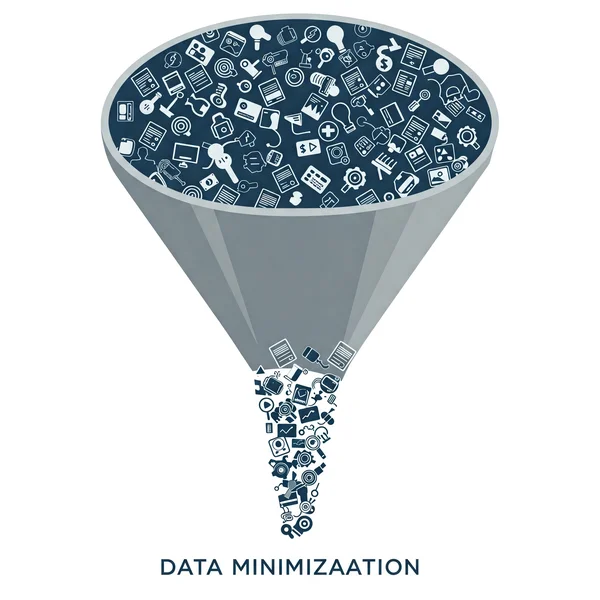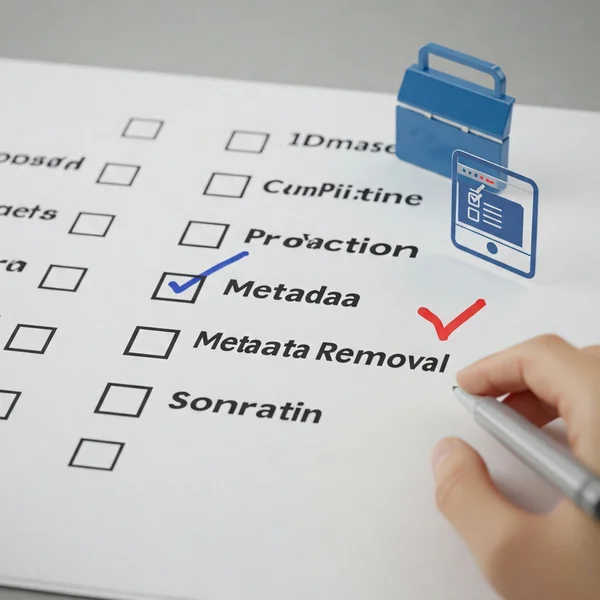Metadata Removal & GDPR: Key to User Data Compliance
The General Data Protection Regulation (GDPR) has fundamentally changed how organizations handle user data. This landmark privacy regulation imposes strict rules on collecting, processing, and storing personal information. While many focus on obvious data points, often overlooked file and image metadata can contain Personally Identifiable Information (PII) or sensitive data, bringing it squarely under GDPR scrutiny. Does GDPR apply to all metadata? Understanding this is vital. This guide explains how proactive metadata removal is essential for achieving GDPR data compliance and safeguarding user rights. For businesses seeking robust solutions, exploring how a metadata scrubbing tool can assist is a crucial step.
What is "Personal Data" Under GDPR and How Does Metadata Fit In?
Under GDPR, "personal data" is broadly defined as any information relating to an identified or identifiable natural person. This isn't just names or addresses; it can include online identifiers, location data, and other digital traces.

Defining PII in Metadata
File metadata GDPR considerations are significant because seemingly innocuous metadata can indeed be PII. This includes:
- Author names embedded in documents.
- Geotags (GPS coordinates) in photos revealing precise locations.
- Timestamps indicating when a file was created or modified by a specific individual.
- Device IDs or software licenses linked to a user.
- Comments or tracked changes containing names or identifiable details.
Examples: Author Names, Geotags, Timestamps, Device IDs as Personal Data
Consider a Word document containing the author's name in its properties, a photo with embedded GPS data from a company event, or a PDF whose metadata logs the creating user's network ID. Each of these pieces of metadata could potentially identify an individual, making it personal data under GDPR.
When Metadata Becomes Sensitive Personal Data
If metadata, directly or indirectly, reveals information about an individual's racial or ethnic origin, political opinions, religious beliefs, health, sex life, or trade union membership, it could be classified as sensitive data. For example, a photo taken at a specific religious gathering with location metadata could imply religious beliefs. Such sensitive data requires even stricter protection under GDPR.
Key GDPR Principles Impacted by File Metadata
Several core GDPR principles are directly affected by how organizations manage file metadata GDPR. Effective data protection requires attention to these details.
Lawfulness, Fairness, and Transparency (Article 5(1)(a))
Organizations must process personal data lawfully, fairly, and transparently. If users are unaware that their PII is being collected and stored within file metadata, this principle can be breached.
Purpose Limitation (Article 5(1)(b))
Data should be collected for specified, explicit, and legitimate purposes and not further processed in a manner incompatible with those purposes. If metadata containing PII is retained without a clear purpose, it can violate this principle.
Data Minimisation (Article 5(1)(c))
This is a cornerstone of GDPR. Organizations should only collect and retain personal data that is adequate, relevant, and limited to what is necessary for the purposes for which it is processed. Much of the automatically generated metadata often fails this test.
Accuracy (Article 5(1)(d))
Personal data must be accurate and, where necessary, kept up to date. Outdated or incorrect metadata (e.g., a wrong author name) can be an issue.
Storage Limitation (Article 5(1)(e))
Personal data should be kept in a form which permits identification of data subjects for no longer than is necessary. Retaining unnecessary metadata indefinitely increases risk and can breach this principle.
Integrity and Confidentiality (Security) (Article 5(1)(f))
Appropriate technical and organizational measures must be taken to ensure the security of personal data, including protection against unauthorized or unlawful data processing and against accidental loss. Unmanaged metadata can be a security loophole.
Accountability (Article 5(2))
The controller is responsible for, and must be able to demonstrate, data compliance with the above principles. This is where accountability GDPR comes into play.
Data Minimization: Why Removing Unnecessary Metadata is Crucial for GDPR
The principle of data minimization is perhaps where metadata removal plays its most direct role in GDPR data compliance.

Reducing the Scope of Personal Data Processed
By actively removing superfluous metadata from files before they are stored or shared, organizations significantly reduce the volume and scope of personal data they process and hold. This inherently lowers risk.
Aligning with the "Collect Only What's Necessary" Mandate
GDPR mandates that you only collect what is strictly necessary. Much of the metadata automatically generated by software and devices (e.g., detailed camera settings, software versions linked to a user) is often not necessary for the primary purpose of the file.
Metadata Removal as a Practical Data Minimization Technique
Implementing a process for metadata removal is a tangible, practical technique to achieve data minimization. It’s a clear action that demonstrates a commitment to reducing user data exposure. Consider how a file metadata scrubber can automate this.
"Privacy by Design and by Default": Integrating Metadata Removal into Processes
GDPR Article 25 emphasizes Privacy by Design and Privacy by Default. This means embedding data protection measures into your systems and processes from the outset.
Embedding Data Protection into Technology and Procedures (Article 25)
Privacy by Design requires organizations to consider data protection implications throughout the entire lifecycle of a project or system. This includes how files containing metadata are created, shared, and stored.
Making Metadata Removal a Standard Operating Procedure
For Privacy by Default, metadata removal should become a standard part of workflows. For instance, before publishing documents online or sharing files externally, a metadata removal step should be automatically or routinely applied.
Tools and Automation for Default Metadata Protection
Leveraging compliance tools that can automate metadata removal helps ensure that this protection is applied consistently and by default, rather than relying on individual user discretion.
Risks of Non-Compliance: Unmanaged Metadata and Potential GDPR Fines
Failing to manage metadata appropriately can lead to significant non-compliance risks GDPR, including substantial GDPR fines.

How Hidden PII in Metadata Can Lead to Breaches
If a data breach occurs and it's found that excessive PII was exposed through unmanaged metadata, this can exacerbate the severity of the breach and the regulatory consequences.
Understanding the Scale of GDPR Penalties
GDPR fines can be severe – up to €20 million or 4% of an organization's global annual turnover, whichever is higher. Risks associated with file metadata GDPR should not be underestimated.
Reputational Damage from Data Protection Failures
Beyond financial penalties, data protection failures, including those related to metadata, can cause significant reputational damage and loss of customer trust.
Practical Steps: Using Metadata Removal for GDPR Compliance
Achieving metadata removal GDPR compliance involves several practical steps.
Conducting a Metadata Audit of Your File Systems
Understand what types of files you store and share, and what kind of metadata they typically contain. Identify where PII or sensitive data might be lurking.
Developing a Metadata Management and Removal Policy
Create a clear policy outlining when and how metadata should be managed and removed. This policy should align with your overall GDPR data protection strategy.
Training Employees on Secure File Handling
Educate employees about the risks of metadata and the importance of following the removal policy, especially when handling user data.
Implementing a Reliable Metadata Removal Solution
Deploy tools to facilitate metadata removal. This could range from features within existing software to dedicated online metadata removal solutions or enterprise-grade software designed for bulk processing.

Documenting Your Metadata Management: Evidence for GDPR Accountability
Under GDPR's accountability principle, organizations must be able to demonstrate their data compliance.
Maintaining Records of Processing Activities (RoPA) for Metadata
Your RoPA should reflect how you handle metadata that constitutes personal data. Documenting your metadata management GDPR practices is key.
Demonstrating Technical and Organisational Measures
Metadata removal policies and the use of removal tools are examples of technical and organizational measures that help demonstrate compliance.
How Documentation Supports Your Compliance Claims
Thorough documentation of your metadata management practices provides crucial evidence if you ever need to demonstrate your due diligence to supervisory authorities.
Proactive Metadata Control: A Pillar of Your GDPR Strategy
Managing file metadata GDPR is not just a technicality; it's a fundamental aspect of robust data protection and GDPR data compliance. Unmanaged metadata can harbor hidden PII, increasing your risk profile. Proactive metadata removal directly supports key GDPR principles like data minimization and privacy by design.
By implementing clear policies, training staff, and utilizing effective tools, organizations can take significant strides in mitigating these risks. Integrating metadata removal into your standard operating procedures is a crucial pillar of your overall GDPR strategy and demonstrates a commitment to protecting user data. What's your biggest challenge in managing metadata for GDPR compliance? Share your insights in the comments below, and consider how dedicated GDPR compliance tools can strengthen your approach.
GDPR and Metadata: Common Questions for Businesses
Here are answers to common questions businesses have regarding GDPR and metadata:
Does GDPR apply to all types of file metadata?
GDPR applies to any metadata that qualifies as "personal data" – i.e., information relating to an identified or identifiable natural person. If metadata (like author name, geolocation, user ID) can be linked to an individual, then GDPR rules for data processing apply.
Is anonymizing metadata sufficient for GDPR, or is removal better?
True anonymization (where data can no longer be re-identified) can meet GDPR requirements. However, achieving robust anonymization of metadata can be complex. Is anonymizing metadata enough for GDPR? Often, if the data is not needed, metadata removal is a simpler and more definitive way to achieve data minimization and reduce risk, especially for PII.
How does the "Right to be Forgotten" relate to metadata?
The Right to Erasure (Article 17) means individuals can request their personal data be deleted. If metadata contains their PII, and a valid erasure request is made, that metadata must also be deleted unless legitimate grounds for retention exist. This highlights the importance of knowing what metadata you hold.
Is a Data Protection Impact Assessment (DPIA) needed for metadata processing?
Is a DPIA needed for metadata processing? A DPIA is required for processing likely to result in a high risk to individuals' rights and freedoms. If your organization processes large volumes of files containing sensitive metadata or PII, or uses it in ways that could significantly impact individuals, a DPIA for your metadata management practices might be necessary.
What kind of tools can help with enterprise-scale metadata removal for GDPR?
For enterprise needs, look for tools that offer:
- Batch processing for large volumes of files.
- Policy-based removal to ensure consistency.
- Support for various file types (documents, images, PDFs).
- Integration with existing workflows or document management systems.
- Logging and reporting features for accountability GDPR. Many organizations find that specialized metadata removal software can be a valuable asset.